#tirid
Explore tagged Tumblr posts
Text

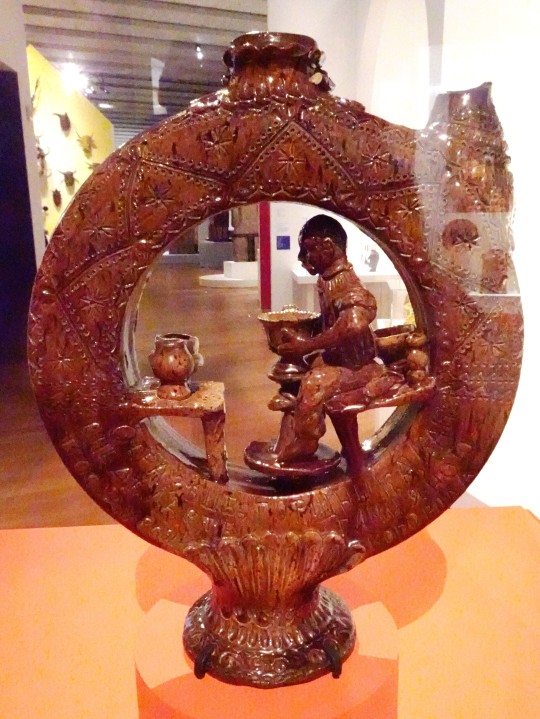




Marseille, le MuCEM et sa nouvelle collection permanente (à mes yeux, bien plus intéressante et mieux présentée que la précédente…)
Suite et fin, enfin !!!
carreau à l'Ange - Iran, 1700
gourde à alcool, dite "kumanet" (percée pour être enfilée autour du bras) - Opishne, Ukraine, début XXe s.
aquamanile, dromadaire - Çannakkale, Turquie, fin XIXe s.
les 3 Saints hiérarques, Basile de Césarée, Grégoire l'Illuminateur, Jean Chrysostome et le roi Tiridate III changé en sanglier, avec Sainte Hripsimé - Kütahya, Anatolie, 1719
porte-huilier - Apt, Provence, XIXe s.
pichet - Corund, Transylvanie, fin XXe s.
#marseille#MuCEM#ange#perse#iran#gourde#kumanet#opishne#ukraine#aquamanile#dromadaire#turquie#çannakkale#ottoman#saint#hiéraque#saint grégoire#saint jean chrysostome#tiridate#tiridate iii#sanglier#hripsimé#huilier#pichet#faïence#transylvanie#roumanie#anatolie#saint basile de césarée#saint grégoire l'illuminateur
2 notes
·
View notes
Text

Khor Virap monastery, Armenia
Khor Virap's notability as a monastery and pilgrimage site is attributed to the fact that Gregory the Illuminator was initially imprisoned here for 13 years by King Tiridates III of Armenia.
125 notes
·
View notes
Text

I drew harry from memory lmao im so tirid
24 notes
·
View notes
Photo
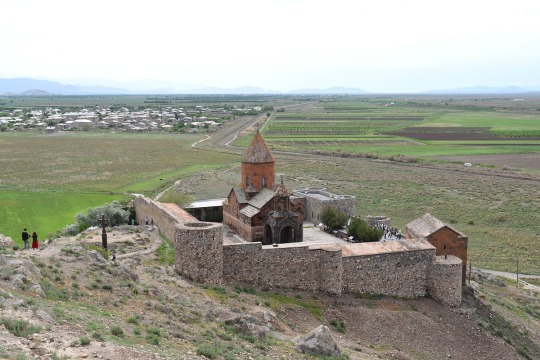
Armenia's Khor Virap Monastery
Khor Virap is an ancient Armenian monastery located near the border with Turkey some 8 km (5 mi) from the town of Artashat, Armenia. It is situated on the Ararat Plain and offers fantastic views of Mt. Ararat in good weather. Legend has it that St. Gregory the Illuminator (c. 257-c. 331 CE) was imprisoned here for 14 years by Tiridates III of Armenia (r. 287-330 CE). Historical record states that a chapel built on the site by Catholicos Nerses III (r. 641-661 CE) — who was also responsible for the construction of Zvartnots Cathedral — in 642 CE. Continuously reconstructed througout the centuries, Khor Virap remains one of the most visited pilgrimage sites in modern Armenia.
Image by James Blake Wiener
59 notes
·
View notes
Note
well i am asking about your nero pdfs
there are many books & nero biographies that give a general analysis of nero's character and/or his principate and are easy to find + access (i always recommend edward champlin and myriam griffin), but aside from these obvious sources, here are some interesting pdfs/articles that i've come across with nero trivia i have not found elsewhere
neronia electronica is an electronic review in several parts, most articles are in french (i do read french & can translate for anyone interested), but some are in english - this is where i've learned that nero wrote his own version of euripides' bacchae
not a pdf, but here is a good link on nero as the antichrist in christian lore. and check out the emperor nero in talmudic legend by s.j bastomsky for nero in jewish lore.
georgios andrikopoulos' magic and the roman emperors has a chapter on nero starting from p.55 describing his interest in the occult and his relationship with tiridates (magus king of parthia). btw, there is a mysterious mention of nero owning a "man eating monster from egypt" for sacrificial purposes - that was probably a crocodile, lol
david braund's treasure trove and nero is about nero's failed search for queen dido's legendary carthaginian treasure, which is also a nero story i didn't know.
lastly, nero and sporus again by michael charles is a good debunking of the (in my opinion piss poor) claim that sporus may have been tiberius' illegitimate heir, but the one interesting piece of information that i have found in it is that there were rumors about nero and otho having been lovers in their younger years. lmao imagine.
this is what comes to mind for now... im always learning about nero & since i am learning about so many other things at the same time i always feel like i'm behind tbh. my current writing project involves nero soo in the upcoming years i will probably know a lottt more and have a lot more pdfs lol but i'm planning on publishing my research on this blog anyway ✌️😊
23 notes
·
View notes
Text
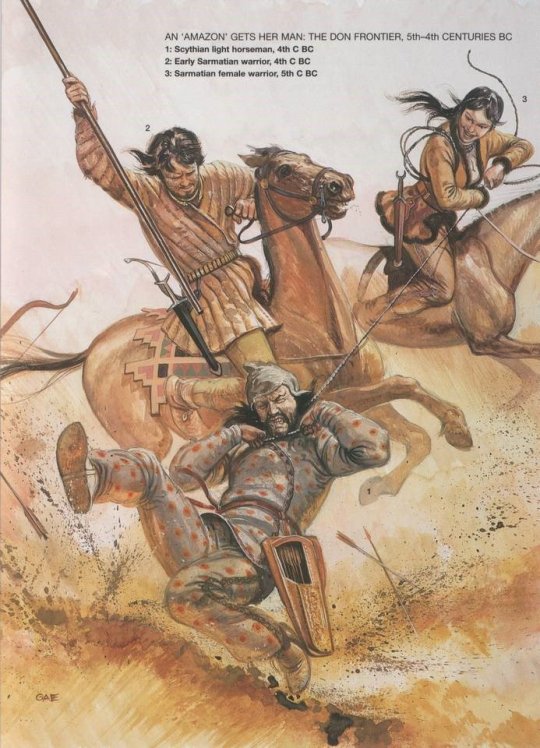
An Amazon gets her man on the Don frontier by Gerry Embleton 2002
"Like most nomads in contact with cattle and wild horses, the Sarmatians employed the lasso, and Sarmatian women were said to have been especially adept in its use. Pomponius Mela (1.21.5) states that Sarmatians tossed the lasso over an enemy's neck to pull him from his horse. Pausanias (1.21.7) describes another technique: 'They throw ropes around any enemies they meet, and then wheel their horses to trip them in the tangle of the rope.' The most famous use of the lasso occurred during the Alan incursion into Parthia in c.AD 73, when the Armenian king Tiridates was caught by a lasso, but managed to cut it with his sword before it tightened around his neck (Josephus, Bell. Jud. 7.7.4).
For several centuries the Don River marked the boundary between Scythian and Sarmatian territories. During the 4th century BC the Sarmatians began to infiltrate across the river, and it is from this period that Greek historians began spinning tales of Amazons, based on the fact that Sarmatian women apparently took part in warfare. Sarmatian girls were supposedly forbidden to marry until they had killed an enemy (Hippocrates, Peri Aeron 17) - or, perhaps more realistically, 'encountered an enemy in combat' (Pomponius Mela, 3.4)."
-The Sarmatians 600 BC-AD 450. R. Brzezinski & M. Mielczarek & G. Embleton. Osprey Publishing.
#sarmatian#scythian#amazons#history#ancient history#literature#classical literature#book art#book illustration#art#pagan
48 notes
·
View notes
Text
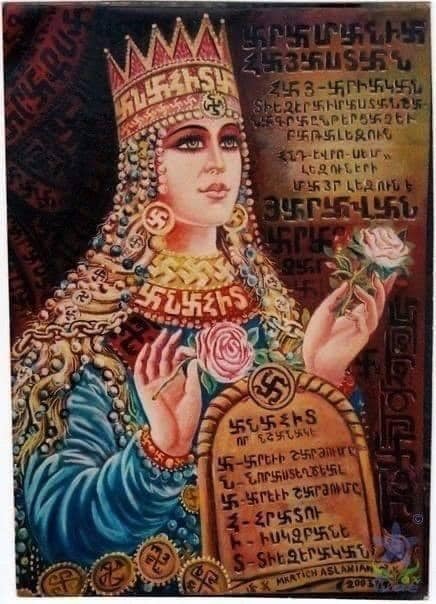
Anahit, Armenian goddess of fertility, healing, wisdom and water. Painting by Mkrtich Aslanian.
According to Strabo, the "Armenians shared in the religion of the Perses and the Medes and particularly honored Anaitis". The kings of Armenia were "steadfast supporters of the cult" and Tiridates III, "prayed officially to the triad Aramazd-Anahit-Vahagn but is said to have shown a special devotion to 'the great lady Anahit, ... the benefactress of the whole human race, mother of all knowledge, daughter of the great Aramazd.”
3 notes
·
View notes
Text
Saints&reading: Saturday, January 27, 2024
january 14 _january 27
HOLY EQUAL-TO-THE-APOSTLES NINA, ENLIGHTENER OF GRUZIA (Georgia_335)
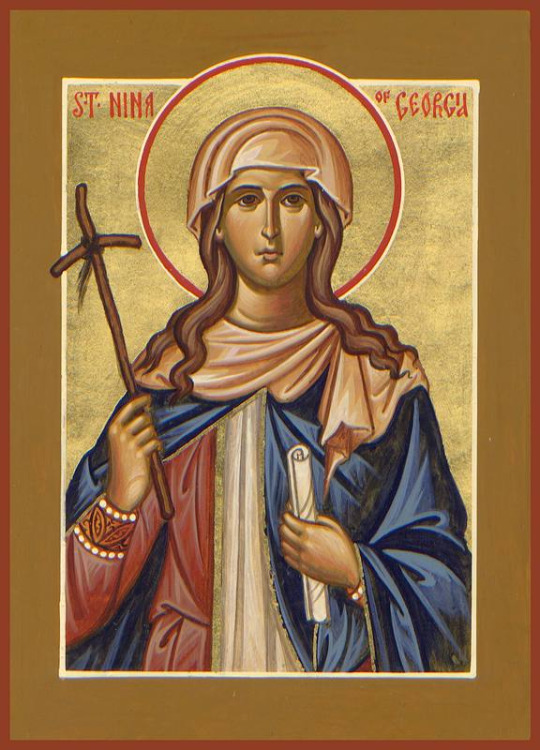
Holy Equal-to-the-Apostles Nina, Enlightener of Gruzia (Georgia), was born in about the year 280 in the city of Kolastra in Cappadocia, where many of the Gruzian people had gathered. Her father Zabulon happened to be a kinsman to the holy GreatMartyr George (Comm. 23 April). He was descended of illustrious lineage and of pious parentage, and he stood in good favour with the emperor, Maximian (284-305). Zabulon, a Christian, served in the military under the emperor, and he took part in the setting free of Christian captives from Gaul (modern France). Saint Nina's mother, Susanna, was a sister of the Jerusalem Patriarch (some suggest named Juvenalios).
[trans. addendum: in 1996 the parents of Saint Nina were enumerated to the ranks of the Saints; the commemoration of Saints Zabulon and Susanna is 20 May]. At twelve years of age Saint Nina went to Jerusalem together with her parents, who had but only this one daughter. By their mutual consent and with the blessing of the Jerusalem Patriarch, Zabulon devoted his life to the service of God at the Jordan, and Susanna was made deaconness in the church of the Sepulchre of the Lord. The upbringing of Saint Nina was entrusted to the pious woman-elder, Nianphora. Saint Nina displayed diligence and obedience over the space of two years: with the help of the grace of God, she got into the firm habit of fulfilling the rule of faith and she read the Holy Scripture zealously.
One time, while in tears reliving the experience of the Gospel passages describing the Crucifixion of Christ the Saviour, the thought would not leave her mind over the fate of the Chiton (Tunic) of the Lord (Jn. 19: 23-24). To the questioning of Saint Nina as to where the Chiton (Tunic) of the Lord had gone (the account about it may be found under 1 October), the woman-elder Nianphora declared that the undecayed Chiton (Tunic) of the Lord, by tradition, had been carried off by the Mtskheta rabbi Eleazar and taken with him back to a place named Iveria (Gruzia or Georgia), and called the Appanage (i.e. the "allotted portion") of the Mother of God. The All-Pure Virgin Herself during Her earthly lifetime had received the Apostolic allotment for the enlightening of Gruzia, but an Angel of the Lord in appearing to Her foretold, that Gruzia would become Her earthly appanage only afterwards upon Her Repose, and that the Providence of God had prepared for Her Apostolic service too at Athos (likewise called the Appanage of the Mother of God). And learning further from the woman-elder Nianphora, that Gruzia had not then yet been enlightened by the light of Christianity, Saint Nina both day and night in prayer besought the Most Holy Mother of God, that She might grant her to see Gruzia converted to Christ, and indeed too might enable her to find the Chiton (Tunic) of the Lord.
The Queen of Heaven heard the prayer of the young righteous one. One time, when Saint Nina was taking rest after long prayer, the All-Pure Virgin appeared to her in a dream, and entrusting her a cross plaited together of vineyard sprigs, She said: "Take thou this cross, for it wilt be for thee a shield and protection against all enemies both visible and invisible. Go thou to the land of Iveria, proclaim there the Gospel of the Lord Jesus Christ and spread forth His grace: and I wilt be thine Protectress". Awakening, Saint Nina saw in her hand the cross (now preserved in a special reliquary in the Tbilisi Zion cathedral church). Rejoicing in spirit, she went to her uncle, the Jerusalem Patriarch, and told him about her vision. The Jerusalem Patriarch thereupon blessed the young virgin in her deed of Apostolic service.
On the way to Gruzia, Saint Nina in miraculous manner escaped a martyr's death under the Armenian emperor Tiridates, which however befell her companions – the emperor's daughter Ripsimia, her guide Gaiania and 35 virgins (Comm. 30 September), who had fled to Armenia from Rome to escape persecution under the emperor Diocletian (284-305). Bolstered in spirit by visions of an Angel of the Lord, appearing the first time holding a incenser, and the second time a scroll in hand, Saint Nina continued on her way and appeared in Gruzia in the year 319. News about her soon spread through the surroundings of Mtskheta, where she asceticised, with numerous signs accompanying her preaching. Thus on the day of the MostGlorious Transfiguration of the Lord, during the time of a pagan sacrificial offering made by pagan priests in the presence of the emperor Mirian and a multitude of the people, through the prayers of Saint Nina were toppled down from an high mountain the idols – Armaz, Gatsi and Gaim. This apparition was accompanied by a strong storm. Having entered Mtskheta, the ancient capital of Gruzia, Saint Nina found shelter in the household of a childless imperial official, the wife of whom – Anastasia, was delivered from her infertility through the prayers of Saint Nina, and she came to believe in Christ.
Saint Nina healed from grievous infirmity the Gruzinian empress Nana, who upon accepting holy Baptism, ceased with her idol-worship and became instead a zealous Christian (Comm. 1 October). In spite of the miraculous healing of his wife, the emperor Mirian (265-342), in heeding the complaints of the pagans, made ready to subject Saint Nina to fierce tortures. "At that very moment, when they did contrive execution for the holy righteous one, the sun darkened and an impenetrable mist covered the place where the emperor was". The emperor suddenly fell blind, and seized by terror his retainers began to beseech their pagan idols for a return of the light of day. "But Armaz, Gaim and Gatsi were deaf, and the darkness did intensify. Then with one voice the terrified cried out to God, Whom Nina did preach. Instantly the darkness dissipated, and the sun shone in all its radiance". This event occurred on 6 May in the year 319.
Emperor Mirian, healed from his blindness by Saint Nina, accepted holy Baptism together with all his retainers. Over the course of several years, by 324 Christianity had ultimately consolidated itself in Gruzia. The chronicles relate, that through her prayers it was revealed to Saint Nina, where the Chiton (Tunic) of the Lord was hid. And at this place was built the first Christian temple in Gruzia (at first a wooden church, but now the stone cathedral, in honour of the Twelve Holy Apostles, the "Svetitskhoveli").
During this period at the request of the emperor Mirian, with the assist of the Byzantine emperor Saint Constantine (306-337), there was dispatched to Gruzia the Antioch bishop Eustathios, with two priests and three deacons. Christianity took an definite hold upon the land. The mountain regions of Gruzia however remained without enlightenment. In the company of the presbyter James and one of the deacons, Saint Nina set off to the upper regions of the Aragva and Iori Rivers, where she preached the Gospel to the pagan hill-people. Many of them came to believe in Christ and accepted holy Baptism. From thence Saint Nina proceeded to Kakhetia (Eastern Gruzia) and settled in the village of Bodbe, in a small tent aside a mountain. Here she led an ascetic life, dwelling in constant prayer, and converting to Christ the surrounding inhabitants. Amidst all these was the empress of Kakhetia, named Sodzha (Sophia), who accepted Baptism with all her court and a multitude of the people.
Having completed her Apostolic service in Gruzia, Saint Nina perceived from above about her impending end. In a letter to the emperor Mirian, she requested him to send bishop John, so that he might prepare her for her final journey. But it was not only bishop John that came, but also the emperor together with all the clergy set off to Bodbe, where at the deathbed of Saint Nina were occurrences of many an healing. For the edification of the people that had come, and at the request of her students, Saint Nina told about her origin and life. This narration, written down by Solomia of Udzharm, has served as the basis of the Vita of Saint Nina. Reverently having communed the Holy Mysteries, Saint Nina gave final instructions that her body be buried at Bodbe, and then she peacefully expired to the Lord in the year 335 (according to other sources, it was in the year 347, at 67 years of age, after 35 years of Apostolic works).
The emperor, together with the clergy and the people – grieving over the death of Saint Nina, wanted to transfer her remains to the Mtskheta cathedral church, but they were not able to remove the coffin of the ascetic from her chosen place of rest. And on this place in the year 342 emperor Mirian started with the foundations, and his son the emperor Bakur (342-364) completed and dedicated the church in the name of Saint Nina's kinsman, the holy GreatMartyr George. Later on at this place was founded a women's monastery in the name of Saint Nina. The relics of the saint, at her command concealed beneathe a crypt, were glorified by many miracles and healings. The Gruzian (Georgian) Orthodox Church, with the assent of the Antioch Patriarchate, designated Saint Nina the Enlightener of Gruzia as in rank Equal-to-the-Apostles, and having enumerated her to the rank of the Saints, established her memory under 14 January, on the day of her blessed end.
© 1996-2001 by translator Fr. S. Janos.
Venerable Stephen, abbot of Chenolakkos Monastery near Chalcedon (716)
VENERABLE STEPHEN ABBOT OF CHENOLAKKOS MONASTERY NEAR CHALCEDON (716)

Saint Stephen lived during the eighth century, and was born into a family in Cappadocia, who raised him in great piety. As he reached maturity, he was greatly impressed by reading the lives of the holy ascetics, and so he visited many monasteries in Palestine in order to observe their way of life. In the wilderness he visited the monasteries of Saints Euthymios the Great (January 20), Savva the Sanctified (December 5) and Theodosios the Great (January 11), studying the Rule (Typikon) of each monastery.
Later, during the reign of the iconoclast Emperor Leo the Isaurian (717-741), he visited Constantinople. The holy Patriarch Germanos (May 12) had a high regard for Stephen, and aided him in building a monastery in Bithynia in which he could establish a monastic Rule based on the great lessons that he had learned in the course of his many years of experience. Saint Stephen founded the Monastery of Khenolakkos [“by the goose-pond”], which was northeast of Triglia (near Moudania in Asia Minor). Many monks were drawn there by reports of his virtue.
Saint Stephen was distinguished for his paternal administration of the monastery, and for his moral influence on the monks. After many years as the Superior of the monastery, the holy ascetic foresaw his own death. When he fell asleep in the Lord, some of the brethren were found worthy to behold the glorious departure of his soul into Heaven, escorted by angels.


EPHESIANS 5:1-8
1 Therefore be imitators of God as dear children. 2 And walk in love, as Christ also has loved us and given Himself for us, an offering and a sacrifice to God for a sweet-smelling aroma. 3 But fornication and all uncleanness or covetousness, let it not even be named among you, as is fitting for saints; 4 neither filthiness, nor foolish talking, nor coarse jesting, which are not fitting, but rather giving of thanks. 5 For this you know, that no fornicator, unclean person, nor covetous man, who is an idolater, has any inheritance in the kingdom of Christ and God. 6 Let no one deceive you with empty words, for because of these things the wrath of God comes upon the sons of disobedience. 7 Therefore do not be partakers with them. 8 For you were once darkness, but now you are light in the Lord. Walk as children of light.
MATTHEW 25:1-13
1 Then the kingdom of heaven shall be likened to ten virgins who took their lamps and went out to meet the bridegroom. 2 Now five of them were wise, and five were foolish. 3 Those who were foolish took their lamps and took no oil with them, 4 but the wise took oil in their vessels with their lamps. 5 But while the bridegroom was delayed, they all slumbered and slept. 6 And at midnight a cry was heard: 'Behold, the bridegroom is coming; go out to meet him!' 7 Then all those virgins arose and trimmed their lamps. 8 And the foolish said to the wise, 'Give us some of your oil, for our lamps are going out.' 9 But the wise answered, saying, 'No, lest there should not be enough for us and you; but go rather to those who sell, and buy for yourselves.' 10 And while they went to buy, the bridegroom came, and those who were ready went in with him to the wedding; and the door was shut. 11 Afterward the other virgins came also, saying, 'Lord, Lord, open to us!' 12 But he answered and said, 'Assuredly, I say to you, I do not know you.' 13 Watch therefore, for you know neither the day nor the hour in which the Son of Man is coming.
#orthodoxy#orthodoxchristianity#easternorthodoxchurch#originofchristianity#spirituality#holyscriptures#gospel#bible#wisdom#saints
3 notes
·
View notes
Quote
In passing, we might say that success is a hideous thing. Its false similarity to merit deceives men. To the masses, success has almost the same appearance as supremacy. Success, that pretender to talent, has a dupe--history. Juvenal and Tacitus only reject it. In our day, an almost official philosophy has entered into its service, wears its livery, and waits in its antechamber. Success: That is the theory. Prosperity supposes capacity. Win in the lottery, and you are an able man. The victor is venerated. To be born with a caul is everything. Have luck alone and you will have the rest; be happy, and you will be thought great. Beyond the five or six great exceptions, the wonders of their age, contemporary admiration is nothing but shortsightedness. Gilt is gold. To be a chance comer is no drawback, provided you have improved your chances. The common herd is an old narcissus, who adores himself and applauds the common. That mighty genius, by which one becomes a Moses, an Aeschylus, a Dante, a Michelangelo, or a Napoleon, the multitude attributes at once and by acclimation to whoever succeeds in his object, whatever it may be. Let a notary rise to be a deputy; let a sham Corneille write Tiridate; let a eunuch come into the possession of a harem; let a military Prudhomme accidentally win the decisive battle of an era; let a pharmacist invent cardboard soles for army shoes and put aside, by selling this cardboard as leather for the army of the Sambre-et-Meuse, four hundred thousand livres in income; let a peddler marry usury and have her bear seven or eight million, of which he is the father and she the mother; let a preacher become a bishop by talking platitudes; let the steward of a good house become so rich that on leaving service he is made Minister of Finance--men call that Genius, just as they call the face of Mousqueton, Beauty, and the bearing of Claude, Majesty. They confuse heaven's radiant stars with a duck's footprint left in the mud.
Victor Hugo, Les Misérables
#i don't believe in great men so this isn't quite how 'i' would frame this idea but sis popped off#i just copied the version in my copy which is the signet classic#i can't vouch for the translation idk i'm new here#long post#les miserables#victor hugo#les mis
3 notes
·
View notes
Text

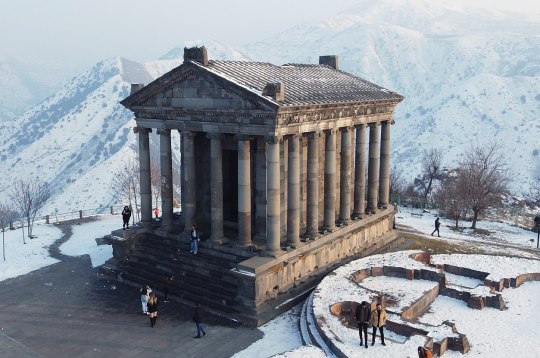
The Temple of Garni (Armenia) is the only standing Greco-Roman colonnaded building in Armenia and the former Soviet Union. Built in the Ionic order, it is located in the village of Garni, in central Armenia, around 30 km (19 mi) east of Yerevan. It is the best-known structure and symbol of pre-Christian Armenia.
The structure was probably built by king Tiridates I in the first century AD as a temple to the sun god Mihr. After Armenia's conversion to Christianity in the early fourth century, it was converted into a royal summer house of Khosrovidukht, the sister of Tiridates III. According to some scholars it was not a temple but a tomb and thus survived the destruction of paganstructures. It collapsed in a 1679 earthquake. Renewed interest in the 19th century led to excavations at the site in early and mid-20th century, and its eventual reconstruction between 1969 and 1975, using the anastylosis method. It is one of the main tourist attractions in Armenia and the central shrine of Hetanism (Armenian neopaganism).
6 notes
·
View notes
Text
early quenya names BUT excluding "q"
Ainden Aindo Ainwen Airdars Aisseme Akaute Aksanna Alane Alarday Alaulinda Aldon Alindar Alingatar Almor Alumnort Alweary Andoldos Andos Anshon Artare Atellow Atessan Atkaseena Atuivara Aukarp Aukiren Awildi Balin Baraure Beass Beecry Beecti Blindo Boldo Bromot Bronevin Canine Capal Capasear Cator Caugh Cherin Chickle Chics Chrisin Cleptalt Clison Clowe Collean Creed Cuivánto Dayan Dooko Dwaldóre Dwiði Eacenta Eandolda Eandu Earchip Eareds Eased Eavairin Ektan Elandl Elanea Elaught Elien Elinga Erdondor Erinen Eringi Esananda Essinsan Exildan Eyons Fainda Faiwar Falaimóre Falanday Fallor Fanas Fanden Fandesse Fanor Fatur Faurwar Fausip Faystrot Febrois Fendowe Fionceft Firilds Firme Firmiske Flanwe Flowen Foarmain Forinolda Forow Fresa Friloine Frinónea Fäerifir Fäerka Gestower Gillo Gnoldo Gnorois Gnowe Goble Golday Golerma Goliss Gweasto Halar Halas Haldo Halka Halkoin Halms Halon Halonda Hartil Heast Helloril Herds Hered Herildo Herun Hesseen Hipeler Hipon Hiponce Hitean Honte Houte Huree Hísear Ichro Ilaull Ildardo Ildons Iliong Ilveftyar Incleia Indeath Inded Inden Inendo Ingaindo Inorwa Inwis Inyastaxe Inóniroad Irier Irines Irisk Irtan Irtinwe Isanne Isillesta Ittleary Ittlele Iveler Iváriru Jandwin Janwinon Kaelwes Kalin Kalkas Kalmauke Kamna Kanda Kappygmi Kaulë Kinda Koiressan Koirth Koite Koiteres Koivildo Koreendl Kosse Kulda Kulki Kulkor Kuluru Kémis Kópaimort Kópakarne Kúnescre Kúvado Kúvalls Kúvien Kûruan Laiwar Landenien Laura Lauru Limalpele Limbach Limper Linboad Lingwen Linie Lintor Linway Linwë Liruhays Loirinom Lomeler Lotsansan Lount Luilóte Luves Lómelman Lómer Lómeáss Mainwe Mainwes Makas Maksanyan Makter Malin Malkapelf Malwe Manwes Mardauker Marea Marth Maste Mavaleian Maven Mavil Mavoing Mekkina Miendo Misoult Mokero Moringa Morow Mánar Múrines Namessed Namisor Nastar Neldrie Nentl Nifeen Ninavalo Nindeafre Nirind Nolie Noloutur Norld Nouds Nuager Nyassion Númin Núrith Oaruhadon Oasky Ogdre Onstorly Opitar Orbarda Ordara Orday Oreldo Orien Orthura Osaka Ostwilles Otelwe Oublearp Outily Oxforder Palas Palloisi Palme Pardomwe Pately Peaprie Pelen Pelution Peoiter Peoppy Petinyon Plachralf Plale Plath Pleat Pluivil Pluvion Poldreang Ponsienme Ponter Porise Porni Preruagle Prics Prisia Purdarver Purgahíru Puron Pygminy Pómeássan Ralaure Ranam Ranin Ranyu Renga Resselea Ringenna Rirendo Roirield Rossecry Rotest Rámanwë Rúmalday Sakea Salauru Salinen Salmost Salverres Sambo Sando Sanst Sanwë Sares Shery Sholdosi Silian Sillyon Silúvane Silúvar Simister Sinwer Sioron Smakansa Smienyon Snorda Sollonwed Sorth Stary Stevar Stillea Sulen Suluveft Suralosan Swate Sworwa Sáyan Súlinwand Súlinóre Súlis Tairme Taldorna Tallowl Tardi Teleeckni Telkand Tetirma Thrin Throot Tilimo Timos Tione Tirids Tivar Tomar Tordani Torie Torristor Tretimi Tulis Tuluntleh Tuorda Tuoreass Tureen Turiele Turil Turmalwe Turon Twilpe Twingalmo Twinwë Twire Táred Ulfiði Ulkala Uolda Uoren Uress Uring Urukilul Vailwe Vaindi Vaites Valahórea Valain Valda Valinceas Valke Valmas Valme Vanda Vandas Vanga Vanwe Varalka Varan Varin Vataikar Velfwin Velmando Velown Vendi Venies Vennin Vessandl Vieldo Voinears Vorni Wandittl Wanto Warnien Watuin Wayst Wedne Werinua Werione Whittana Whome Whonshar Wilinwean Winena Winwen Worme Wounne Yessimb Yongai Ílifuin Úrinde
1 note
·
View note
Text
Les Mis said don't confuse the mud with the stars, the appearance with the reality!
Be it said in passing, that success is a very hideous thing. Its false resemblance to merit deceives men. For the masses, success has almost the same profile as supremacy. Success, that Menæchmus of talent, has one dupe,—history. Juvenal and Tacitus alone grumble at it. In our day, a philosophy which is almost official has entered into its service, wears the livery of success, and performs the service of its antechamber. Succeed: theory. Prosperity argues capacity. Win in the lottery, and behold! you are a clever man. He who triumphs is venerated. Be born with a silver spoon in your mouth! everything lies in that. Be lucky, and you will have all the rest; be happy, and people will think you great. Outside of five or six immense exceptions, which compose the splendor of a century, contemporary admiration is nothing but short-sightedness. Gilding is gold. It does no harm to be the first arrival by pure chance, so long as you do arrive. The common herd is an old Narcissus who adores himself, and who applauds the vulgar herd. That enormous ability by virtue of which one is Moses, Æschylus, Dante, Michael Angelo, or Napoleon, the multitude awards on the spot, and by acclamation, to whomsoever attains his object, in whatsoever it may consist. Let a notary transfigure himself into a deputy: let a false Corneille compose Tiridate; let a eunuch come to possess a harem; let a military Prudhomme accidentally win the decisive battle of an epoch; let an apothecary invent cardboard shoe-soles for the army of the Sambre-and-Meuse, and construct for himself, out of this cardboard, sold as leather, four hundred thousand francs of income; let a pork-packer espouse usury, and cause it to bring forth seven or eight millions, of which he is the father and of which it is the mother; let a preacher become a bishop by force of his nasal drawl; let the steward of a fine family be so rich on retiring from service that he is made minister of finances,—and men call that Genius, just as they call the face of Mousqueton Beauty, and the mien of Claude Majesty. With the constellations of space they confound the stars of the abyss which are made in the soft mire of the puddle by the feet of ducks.
#les mis#les miserables#victor hugo#viktor hugo#les mis letter#les mis letters#quote#stars#quotes#literature#think
5 notes
·
View notes
Text
Atlantean language lyrics
Movie: Atlantean the lost empire
.
Atlantis destruction
Nipuk!
Gwis-it tirid megid-i-im-en!
Shom kuleb-et-ot!
Lud-en-tem wil-ag
kaber -s-e-kem!
Nal yoden-et-ot!
Te.wan-top!
Tegul-en-tem gom nu rosh-yoh!
Wesh.ek.mol!
Din-noh!
Ot, ta neb-top, Kiy.ish!
Kida-top, masik!
Kida-top!
Tok-it ser kupeg!
Nal-tem wanat-e-kem!
mat im!
Okwep-en-tem moh-in derem, Kida-top!
.
.
Milo meets kida
Tug po yugeb-in habed-e-tot
Lat saldup-e-tot dap?
Tug kunet saldup hop-e-tot
Ad lud won kwetip-i-mot dap?
Tug-it gwenog tus-e-kem du?
Kwam!
.
.
the team meet kida
Neshing-en-tem gebr-in de pen-yoh.
Leb es-e-neh dup, duwer-en-top?
Lat suldup-e-neh dup?
Leb es-e-neh dup duwer-en-top.
Lat suldup-e-neh dup.
Prawit-tem dangun-ag moh-in yugeb-l-et-ot bet kaper-ek-ik.
Kag...wegen-e ... prid
Kag wegen-os prid-uses es-e-nen.
.
.
Kida and her father
Degim, Taneb-top. Weydag-os-en(-tem) neb-et bernot-i-b-mik.
Moh tamar gwis-in panneb-len-en, Kida-top. Wil-tem neb gamos-e-tot deg duwer-en tirid.
Tab-top, lud-en neb-et kwam gesu bog-e-kem deg yasek-en gesu-go-ntoh.
Gwis dosep-tem sob-in kwam alit-e-kem.
Ad Tab-top ...
Pasil-le-tot. Tages dot-esh-tem neb yutep-o-nkem.
.
.
Milo reading
Okay, uh ...
Leweg-tem shib-an pak ben-tem digen-mil satib.
Yus keran-tem sha-dlag komtib-lo-nen.
.
.
The machine is activated
Yadlug-o-nih
.
.
The team betraying Milo
Kobden-en tuh-in epkel-yoh.
Moh-it gwenog-l-o-nik!
.
.
Kida praying
Nish-en-top Adlantis-ag, Kelob-tem Gabr-in karok-l-im-ik bet
gim demot-tem net getan-os-en-tem bernot-l-im-ik bet
kag-ib lewid-yoh.
Solesh mat-o-not, Maylo Thatsh-top.
Kwam tered-s-e-nen.
6 notes
·
View notes
Photo

Khor Virap
Khor Virap is a monastery located in Armenia that was first established in 642 CE. Its name is derived from "virap nerk'in," which means "deep dungeon" in Armenian. Khor Virap is one of the most sacred and visited sites in Armenia primarily due to the legend of Saint Gregory the Illuminator who was imprisoned for 13 years in Khor Virap's dungeon before succeeding in the conversion of King Tiridates (Trdat) the Great to Christianity in the first decades of the 4th century CE. During the Middle Ages, Khor Virap was a center of education and learning, and despite a colossal earthquake in 1679 CE, it remains a site of pilgrimage and immense cultural interest to Armenians today.
Learn more about Khor Virap
46 notes
·
View notes
